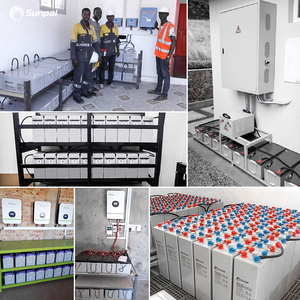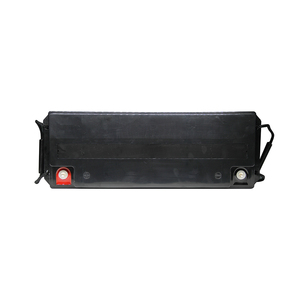(594 products available)















































































































































































































Gel batteries are ideal for multiple applications as they use silica to give the electrolyte a jelly-like consistency. The gel assists with minimizing the rate of water loss, warranting the batteries can operate at higher temperatures. Their sealed design means that, unlike their silica-acid counterparts, they do not need regular watering, making them low maintenance.
Due to their resilience, gel batteries fit well in solar energy systems, electric wheelchairs, and forklifts. Here, deep cycling is normally a requirement. They are also popular in marine applications due to their spill-proof design, which allows safe installation in multiple positions.
AGM (Absorbed Glass Mat) batteries feature fiberglass separators that absorb electrolyte solutions, rendering them spill-proof. Their construction allows them to recover even after extreme usage. The vibration resistance makes them very durable in settings with a lot of oscillation. AGM batteries also have a high discharge rate and recharge quickly.
These batteries operate perfectly in vehicles fitted with modern electrical systems, uninterrupted power supply systems, and energy storage solutions. They are also commonly used in marine applications due to their ability to resist harsh conditions and water-proof design. The rapid absorption of the electrolyte allows AGM batteries to be used in settings that need high power output.
Known for their durability and reliability, OPzV batteries offer commendable performance in demanding environments. What sets them apart is their robustness and ability to withstand extreme temperature conditions. They also have a large consumption cycle, which means they can be discharged deeper without harming the battery. This makes them a dependable long-term investment for enterprises.
Additionally, OPzV batteries are built to last and ideal for critical power backup in telecoms, industrial applications, and UPS (Uninterruptible Power Supply) systems. Given their maintenance-free operation, they provide a dependable power solution with minimal intervention for businesses.
For telecommunications companies, constant power is essential. RITAR batteries store energy to back up systems during outages. OPzV models are particularly fitting, offering long discharge times. They ensure network reliability by keeping communication uninterrupted during power challenges.
Commercial and industrial settings, especially large ones, rely a lot on uninterrupted power supply (UPS) systems. Here, batteries act as a safety net during power outages by seamlessly switching to battery power. Companies use AGM batteries for this purpose due to their quick charging ability and compact size.
These batteries guard vital servers, data storage units, and production equipment, averting potential damage or downtime. With AGM's high vibration resistance, these batteries are often used in areas with a lot of machinery, ensuring continuous operation.
Off the grid or on the grid, RITAR batteries play a crucial role in solar energy systems. As renewable energy sources become more popular, people are turning to gel and AGM batteries to store energy for cloudy days or nighttime. Gel batteries are especially designed to endure frequent deep discharge cycles, making them ideal for solar applications. They also have good energy retention and can last long periods without discharge. These characteristics make them ideal for residential and commercial solar setups.
The marine industry faces tough conditions, necessitating reliable power sources. RITAR marine batteries, including gel and AGM types, resist vibrations and are spill-proof, making them fit for boats and yachts. These batteries power navigation systems, communications equipment, and onboard appliances, guaranteeing smooth operation.
Moreover, their capacity to withstand oscillation and harsh marine settings increases their longevity. This feature gives boat owners and businesses a dependable battery for leisure and commercial fleets.
AGM and Gel batteries provide the ideal energy requirements for forklifts and other industrial vehicles. In warehouses and manufacturing plants, these batteries power electric forklifts, providing an efficient work method while avoiding emission concerns. The high energy density of AGM coupled with the robustness of gel technology, these batteries are resilient to heavy use and long operation hours.
They also have quick charge cycles, minimizing downtime and maximizing productivity. Businesses benefit by working efficiently while obtaining a greener approach to their material and product handling.
VRLA Technology
RITAR batteries feature Valve Regulated Lead Acid (VRLA) technology. It ensures the gases generated during charging are recirculated, preventing the electrolyte from evaporating. This makes the batteries maintenance-free.
Cycling Capacity
Deep cycle batteries feature a robust cycling capacity. Users discharge them frequently without causing damage. This makes them ideal for applications that require sustained power over extended periods.
Sealed Design
The sealed designs for Gel and AGM batteries mean they do not need regular watering or maintenance. It makes them fitting for operations that require minimal supervision.
Resistant To Vibrations
AGM batteries are highly resilient to vibrations. This is important for vehicles and marine applications that experience consistent movements. Their robust internal construction ensures the battery remains stable even in the toughest environments.
Temperature Tolerance
RITAR batteries perform well in extreme temperatures. They achieve this by designing components that either prevent overheating or continue performing in high-heat settings. This characteristic guarantees reliable operation in multiple environments.
Installation Guidelines
When installing a RITAR battery, always begin by selecting an area that is temperate and well-ventilated. Batteries are sensitive to temperature changes, and placing them in an ideal environment enhances their efficiency. After this, secure the battery in a stationary position to avoid possible movement that might dislocate the terminals and cables.
Connecting The Battery
Begin with connecting the positive terminal first. It helps diminish the risk of short-circuits. Use a wire brush to clean the battery terminals, thus guaranteeing a solid connection. Next, attach the red cable to the positive terminal and the black wire to the negative one.
Charging
Before the initial usage, ensure the battery is fully charged. This helps it set a solid memory and guarantees longevity. Follow the manufacturer's guidelines while using the right charger to obtain optimal results.
Safety Precautions
Always wear safety gear when installing a RITAR battery. This includes gloves and goggles. Remember to work in a well-ventilated environment, mainly if the battery emits possible dangerous gases. Disconnect devices that may draw power from the battery during installation.
Maintenance Guidelines
Proper maintenance of RITAR batteries increases their lifespan. What do routine checks entail? Checking for corrosion on terminals and cleaning them to allow optimal power transfer. Tighten loose connections, but be cautious not to overdo it, as that may cause terminal damage.
Regular Testing
Test the batteries routinely using a multimeter to guarantee they still have the correct voltage. Any significant drop means a replacement is due required. Another good practice is performing a equalization charge, especially on lead-acid batteries. It balances the charge across all cells and stops stratification.
Watering (For Lead Acid Batteries)
Lead-acid batteries require frequent checks of water levels. Add distilled water when levels are low, but be sure not to overfill. It can cause the electrolyte to overflow and generate a dangerous mixture. Only use distilled water because it is free of minerals that may harm the battery.
Repairs
DIY repairs are not advised when it comes to batteries. Always look for professional help when there is an issue. The professionals know how to handle battery plates that are sulphated or damaged.
Material Selection
The materials that make RITAR batteries hugely determine how long they will last. Top-quality materials mean better conductivity, chemical resistance, and structural integrity, thus overall enhanced performance.
Manufacturing Processes
Close-knit manufacturing means there will be fewer defects. It is important that the process adopt strict quality control measures at each stage, from lead alloying to paste application. This warrants that each battery meets the predetermined standards and specifications.
Component Verification
The battery components, such as the separator, plates, and electrolyte, must pass the required standards. They must be compatible with one another to ensure optimal performance. For instance, gel additives of poor quality can affect the viscosity and battery lifespan.
Testing
Benchmarking stage testing for capacity, efficiency, and safety characteristics checks is carried out before the commercial release. Independent bodies also test RITAR batteries to check compliance with local and international standards.
RITAR batteries have multiple certifications for quality and safety. They are renowned globally and operate according to the ISO9001 quality management system. In 2006, they received the ISO14001 award for environmental management.
Moreover, they received the OHSAS18001 certification for occupational health and safety management. That signifies their focus on worker health and safety. Many national and international standards bodies recognize them, including Britain's BSI and Germany's TUV.
They also adhere to RoHS and REACH regulations, which ensure restricted usage of hazardous substances and promote chemical safety in the battery supply chain, respectively. Other certifications include CE, UL, and WHA.
Safety Testing
Safety testing prevents possible hazards, such as explosions or leaks. It normally includes overcharge, short circuit, and drop tests. Batteries that pass the above tests make them fit for high-risk environments where there may be fluctuations in temperatures.
Cycle Life Testing
This testing involves repeatedly discharging and charging the battery to measure its cycle life. A longer cycle life means the battery can handle more charge and discharge cycles without wearing down. This is a key consideration for customers looking for long-term performance.
Temperature Test
The test evaluates how the battery performs in extreme heat and cold. Batteries that maintain efficiency in these conditions are labeled more versatile and reliable for outdoor or unconditioned indoor use.
Certification
Once the batteries undergo and pass the testing, they receive certifications from recognized agencies like UL, CE, and RoHS. These certifications enhance the battery's market credibility and ensure consumers that it meets safety and environmental standards.
ISO Certificates
RITAR batteries have multiple ISO certifications. They include ISO9001 for quality management and ISO14001 for environmental management. These certificates are indicators of systematic approaches to quality and ecological guarding.
Product Safety Certificates
A range of products, including RITAR batteries, possess safety certifications like UL and CE. They signify that the products meet safety standards for electrical devices. Batteries only receive these certifications after they have undergone rigorous safety tests.
RoHS and REACH Compliance
RITAR ensures its batteries comply with RoHS and REACH regulations. These regulations restrict dangerous substances and promote chemical safety in the battery supply chain. Such compliance guarantees that RITAR is committed to both product safety and environmental sustainability.
AGM batteries are resilient to vibrations, have quick charge times, and are spill-proof. Consequently, they are commonly used in vehicles and marine settings where movement is the order of the day.
Gel batteries come with a sturdy plate design and a gel-like electrolyte that evenly suspends the active material. It allows them to endure frequent deep discharge cycles without harm.
RITAR batteries comply with RoHS and REACH. These standards restrict hazardous substances and advocate for chemical safety in the battery supply chain. The compliance shows how committed RITAR is to ecological wellbeing.
OPzV batteries are constructed for durability. They have thick plates and long cycle tests to withstand extended usage. These batteries are typically employed in industrial and commercial businesses that require power continuity.
RITAR batteries are ideal for renewable energy applications. AGM and Gel batteries store excess energy from solar systems. They offer dependable energy supply when the primary source is unavailable.